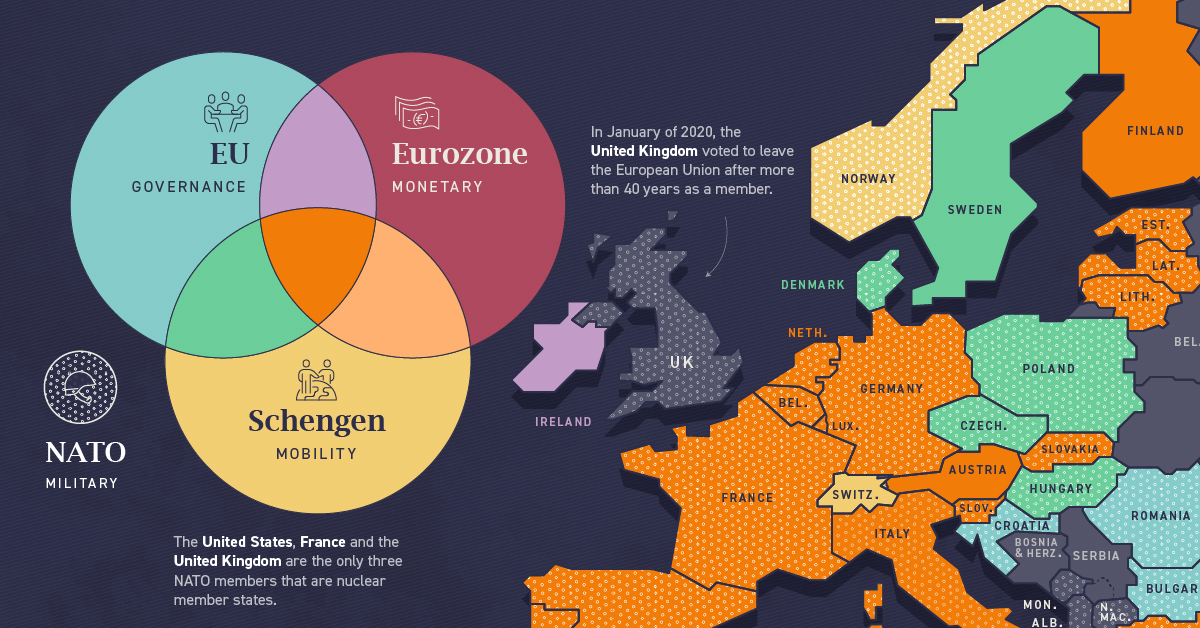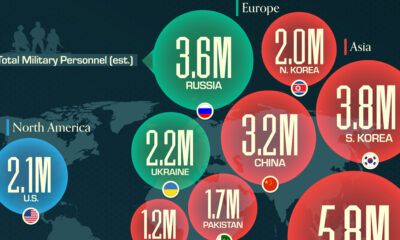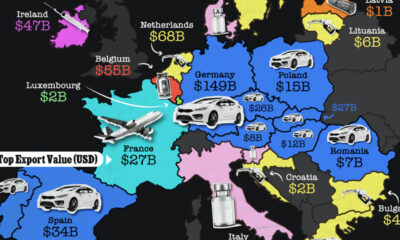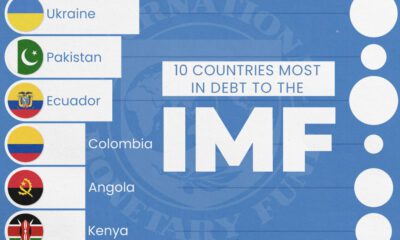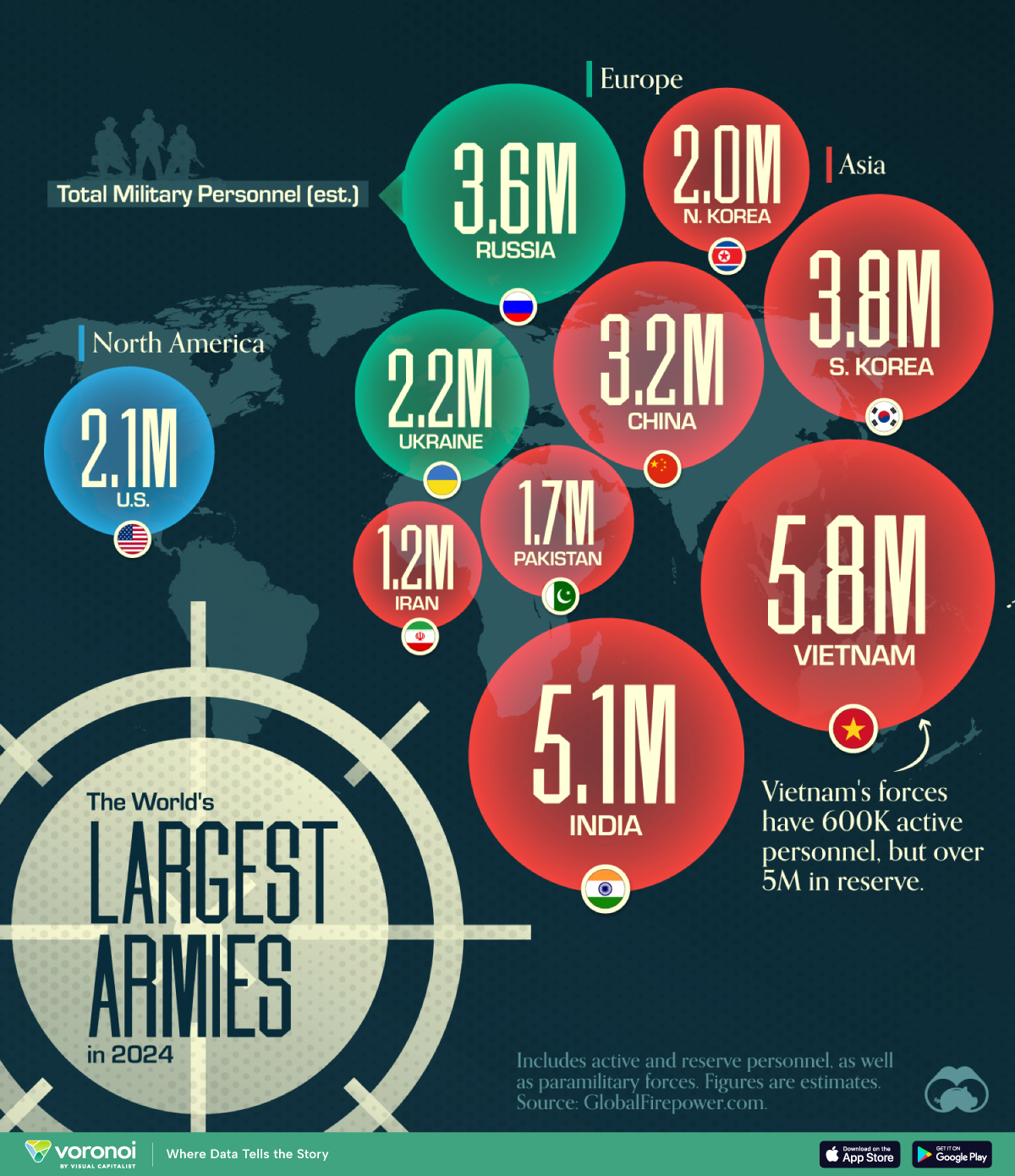Politics
A Visual Guide to Europe’s Member States
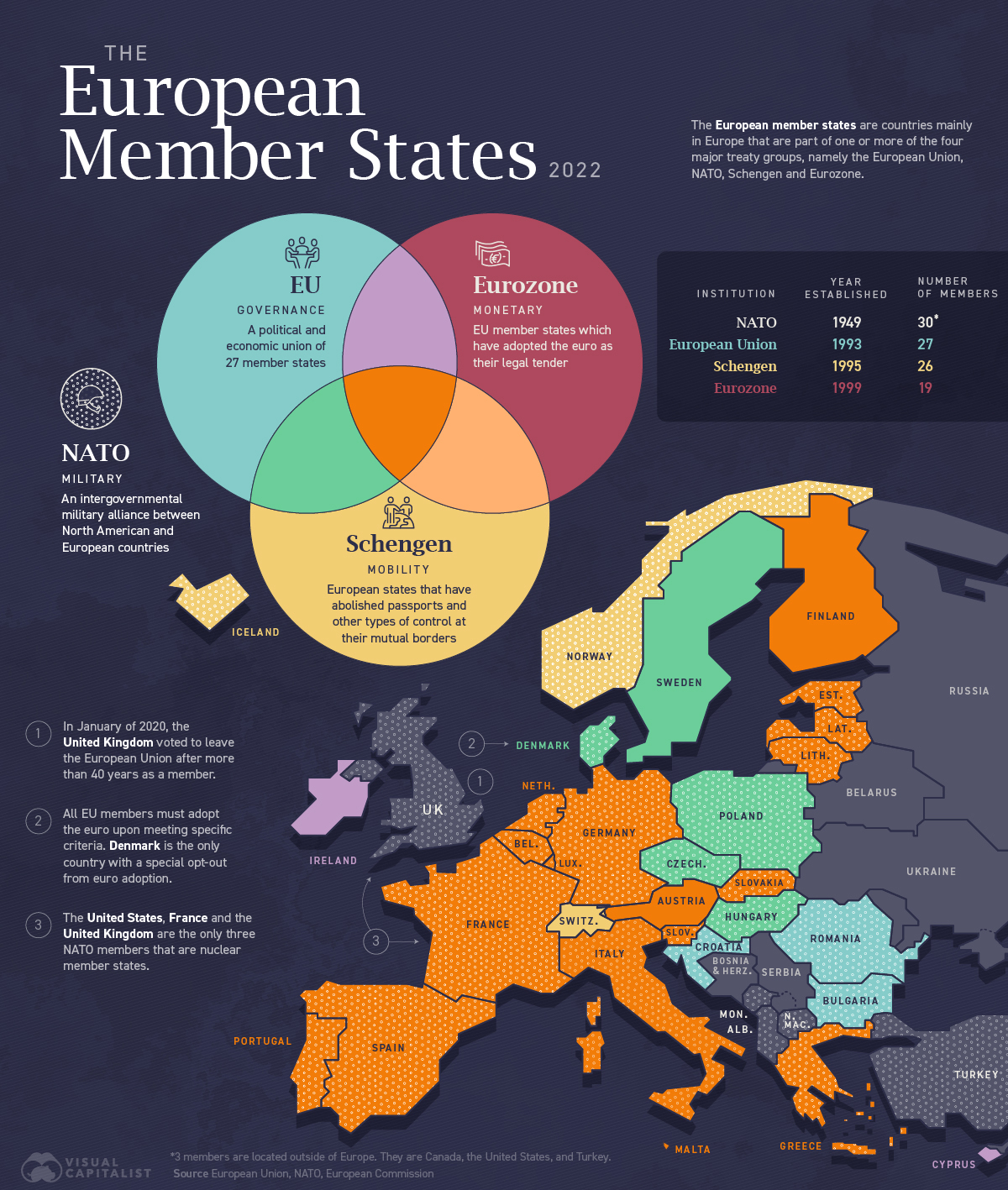
Who are Europe’s Member States?
With Ukraine’s recent bid to join the European Union (EU), the current status of Europe’s member states is back in the fray.
The European member states are countries mainly in Europe, and three outside, that are part of one or more of the four major treaty groups, namely the European Union (EU), NATO, Schengen, and eurozone.
Each of these institutions governs a different aspect of the region’s infrastructure.
Let’s take a look at each of them.
European Union
The European Union (EU) is a unique economic and political union between 27 European countries.
First created as the European Economic Community in the aftermath of WW2, the organization’s main focus was to foster economic cooperation. The idea was simple: countries that trade with one another and become economically interdependent are more likely to avoid conflict.
Beginning with six countries in 1958, the European Economic Community has since added 21 more countries (the UK left the EU in 2020), with a primary focus on single or internal markets.
Here are the countries that comprise the European Union:
| Number | Countries | Year of Accession |
|---|---|---|
| 1 | 🇦🇹 Austria | 1995 |
| 2 | 🇧🇪 Belgium | Founder |
| 3 | 🇧🇬 Bulgaria | 2007 |
| 4 | 🇭🇷 Croatia | 2013 |
| 5 | 🇨🇾 Cyprus | 2004 |
| 6 | 🇨🇿 Czech Republic | 2004 |
| 7 | 🇩🇰 Denmark | 1973 |
| 8 | 🇪🇪 Estonia | 2004 |
| 9 | 🇫🇮 Finland | 1995 |
| 10 | 🇫🇷 France | Founder |
| 11 | 🇩🇪 Germany | Founder |
| 12 | 🇬🇷 Greece | 1981 |
| 13 | 🇭🇺 Hungary | 2004 |
| 14 | 🇮🇪 Ireland | 1973 |
| 15 | 🇮🇹 Italy | Founder |
| 16 | 🇱🇻 Latvia | 2004 |
| 17 | 🇱🇹 Lithuania | 2004 |
| 18 | 🇱🇺 Luxembourg | Founder |
| 19 | 🇲🇹 Malta | 2004 |
| 20 | 🇳🇱 Netherlands | Founder |
| 21 | 🇵🇱 Poland | 2004 |
| 22 | 🇵🇹 Portugal | 1986 |
| 23 | 🇷🇴 Romania | 2007 |
| 24 | 🇸🇰 Slovakia | 2004 |
| 25 | 🇸🇮 Slovenia | 2004 |
| 26 | 🇪🇸 Spain | 1986 |
| 27 | 🇸🇪 Sweden | 1995 |
What began as a purely economic union has evolved into an organization pioneering the development of many different policy areas. A name change from the European Economic Community to the European Union in 1993 reflected this.
NATO
The North Atlantic Treaty Organization (NATO) exists for the sole purpose of facilitating a political and military alliance between its 30 member countries.
Established in 1949 in response to post-WW2 Soviet aggression, NATO exists for the collective defense and security of the group. Members share few laws and regulations. An attack on one constitutes an attack on all, and member states are obligated to defend one another.
The chronological timeline of NATO’s expansion since its establishment paints a fascinating picture.
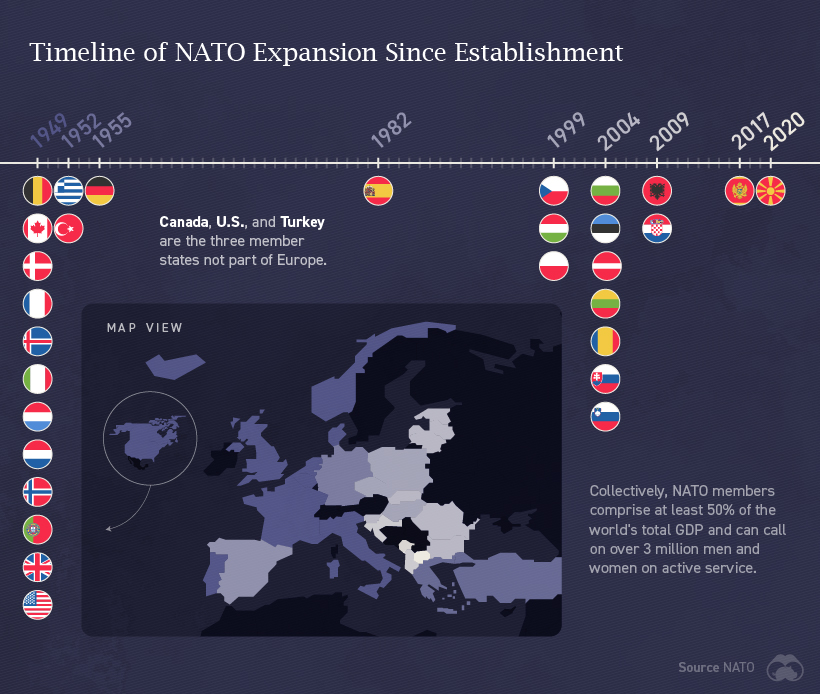
As of 2021, NATO officially recognizes three aspiring NATO members: Bosnia and Herzegovina, Georgia, and Ukraine. Ukraine has voiced its desire to join NATO since 2014 but hasn’t met its political and military criteria.
Eurozone
The eurozone is a geographic and economic region that consists of countries that have adopted the euro as their national currency. Approximately 340 million people live in the euro area.
Today, the eurozone consists of 19 countries of the European Union. Here they are:
| Number | Countries | Year of Adoption |
|---|---|---|
| 1 | 🇦🇹 Austria | 1999 |
| 2 | 🇧🇪 Belgium | 1999 |
| 3 | 🇨🇾 Cyprus | 2008 |
| 4 | 🇪🇪 Estonia | 2011 |
| 5 | 🇫🇮 Finland | 1999 |
| 6 | 🇫🇷 France | 1999 |
| 7 | 🇩🇪 Germany | 1999 |
| 8 | 🇬🇷 Greece | 2001 |
| 9 | 🇮🇪 Ireland | 1999 |
| 10 | 🇮🇹 Italy | 1999 |
| 11 | 🇱🇻 Latvia | 2014 |
| 12 | 🇱🇹 Lithuania | 2015 |
| 13 | 🇱🇺 Luxembourg | 1999 |
| 14 | 🇲🇹 Malta | 2008 |
| 15 | 🇳🇱 Netherlands | 1999 |
| 16 | 🇵🇹 Portugal | 1999 |
| 17 | 🇸🇰 Slovakia | 2009 |
| 18 | 🇸🇮 Slovenia | 2007 |
| 19 | 🇪🇸 Spain | 1999 |
European Union nations that decide to participate in the eurozone must meet a multitude of financial requirements. They include price stability, sound public finances, the durability of convergence, and exchange rate stability.
Not all countries have to adopt the currency, though. For example, Denmark has a special opt-out clause to use its own currency and maintain its financial independence.
Schengen
The Schengen Area comprises 26 European countries that agreed to create common entry and exit requirements to remove the need for internal borders. This allows travellers up to 90 days of visa-free travel to any of the countries in the Schengen Area.
The border-free Schengen Area guarantees free movement to more than 400 million EU citizens, along with non-EU nationals living in the EU or visiting as tourists, exchange students, or for business purposes.
Here’s a list of the 26 countries that are a part of the Schengen Area:
| Number | Countries | Year of Implementation |
|---|---|---|
| 1 | 🇦🇹 Austria | 1997 |
| 2 | 🇧🇪 Belgium | 1995 |
| 3 | 🇨🇿 Czech Republic | 2007 |
| 4 | 🇩🇰 Denmark | 2001 |
| 5 | 🇪🇪 Estonia | 2007 |
| 6 | 🇫🇮 Finland | 2001 |
| 7 | 🇫🇷 France | 1995 |
| 8 | 🇩🇪 Germany | 1995 |
| 9 | 🇬🇷 Greece | 2000 |
| 10 | 🇭🇺 Hungary | 2007 |
| 11 | 🇮🇸 Iceland | 2001 |
| 12 | 🇮🇹 Italy | 1997 |
| 13 | 🇱🇻 Latvia | 2007 |
| 14 | 🇱🇮 Liechtenstein | 2011 |
| 15 | 🇱🇹 Lithuania | 2007 |
| 16 | 🇱🇺 Luxembourg | 1995 |
| 17 | 🇲🇹 Malta | 2007 |
| 18 | 🇳🇱 Netherlands | 1995 |
| 19 | 🇳🇴 Norway | 2001 |
| 20 | 🇵🇱 Poland | 2007 |
| 21 | 🇵🇹 Portugal | 1995 |
| 22 | 🇸🇰 Slovakia | 2007 |
| 23 | 🇸🇮 Slovenia | 2007 |
| 24 | 🇪🇸 Spain | 1995 |
| 25 | 🇸🇪 Sweden | 2001 |
| 26 | 🇨🇭 Switzerland | 2008 |
Monaco, Vatican City, and San Marino also have open borders with Schengen area countries even though they aren’t part of the treaty.
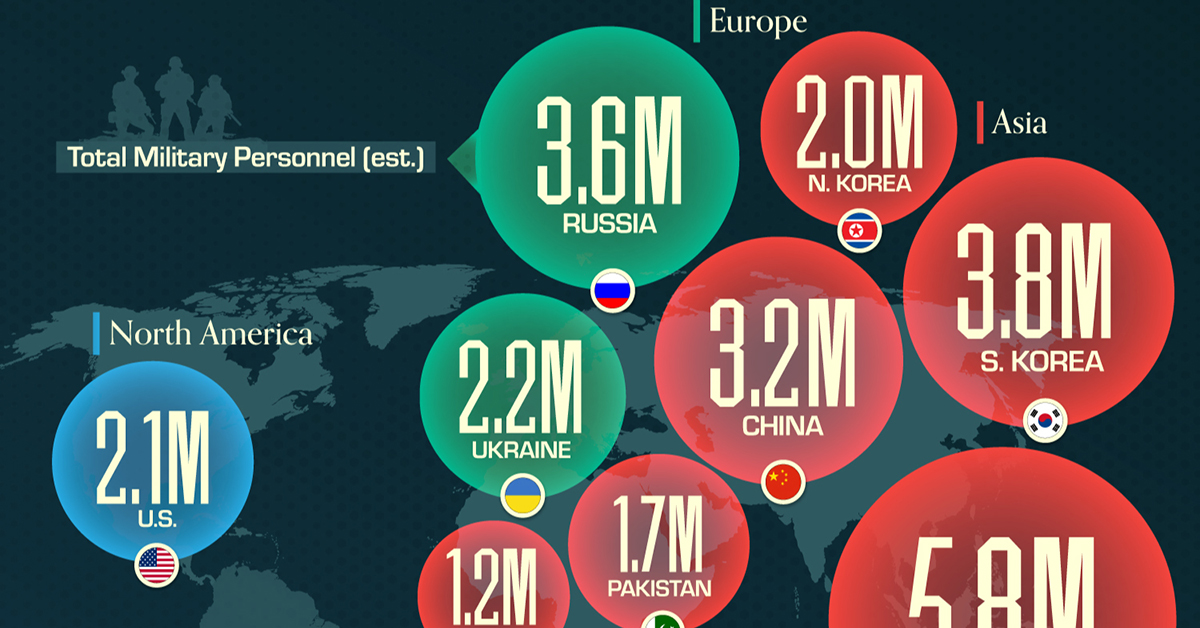
Mapped: The World’s Largest Armies in 2024
This was originally posted on our Voronoi app. Download the app for free on iOS or Android and discover incredible data-driven charts from a variety of trusted sources.
Despite being considered the biggest military force in the world, the United States doesn’t have the largest army in terms of personnel.
This graphic shows the top 10 countries by military personnel as of May 2024, including active and reserve personnel, as well as paramilitary forces. It is based on estimates from GlobalFirepower.com.
Vietnam, India, and South Korea Have the Biggest Armies
China has the largest standing army, with over 2 million active personnel. With increasing defense spending over the last decades, the country also ranks third in the number of tanks and second in the number of aircraft carriers in service.
When reserve personnel are included, however, the Chinese military falls behind those of Vietnam, India, South Korea, and Russia.
Vietnam’s forces include 600,000 active personnel and over 5 million in reserve. This is because Vietnam, along with countries like South Korea and Israel, has a standing policy of conscription for young adults.
| Country | Total Military Personnel (est.) | Region |
|---|---|---|
| 🇻🇳 Vietnam | 5.8M | Asia |
| 🇮🇳 India | 5.1M | Asia |
| 🇰🇷 South Korea | 3.8M | Asia |
| 🇷🇺 Russia | 3.6M | Europe/Asia |
| 🇨🇳 China | 3.2M | Asia |
| 🇺🇦 Ukraine | 2.2M | Europe |
| 🇺🇸 United States | 2.1M | North America |
| 🇰🇵 North Korea | 2.0M | Asia |
| 🇵🇰 Pakistan | 1.7M | Asia |
| 🇮🇷 Iran | 1.2M | Middle East |
Interestingly, the 2022 Russian invasion of Ukraine resulted in a massive increase in Ukrainian personnel numbers. Active personnel rose from around 170,000 in 2016 to over 900,000.
Despite not having the largest army, the U.S. accounts for almost 40% of global military expenditures, with its 2022 spending totaling $877 billion.
China ranked second in absolute terms, accounting for another 13% of world military expenditure at $292 billion.
-
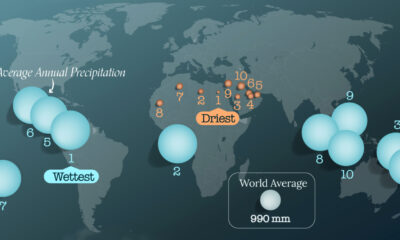
 Maps1 week ago
Maps1 week agoMapped: The World’s Wettest and Driest Countries
-
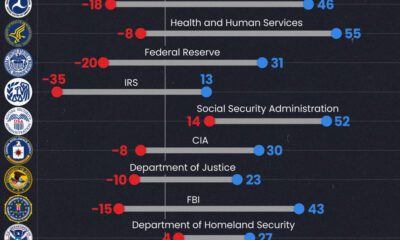
 Public Opinion2 weeks ago
Public Opinion2 weeks agoCharted: How Democrats and Republicans View Government Agencies
-

 Economy2 weeks ago
Economy2 weeks agoMapped: The Top Exports in Asian Countries
-
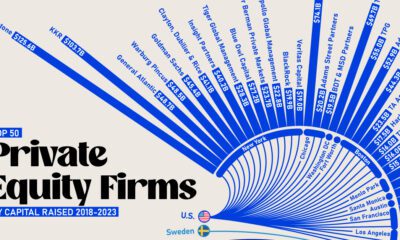
 Venture Capital2 weeks ago
Venture Capital2 weeks agoRanked: The World’s 50 Largest Private Equity Firms
-

 United States2 weeks ago
United States2 weeks agoMapped: The 10 U.S. States With the Lowest Real GDP Growth
-

 Economy2 weeks ago
Economy2 weeks agoComparing New and Current U.S. Tariffs on Chinese Imports
-

 China2 weeks ago
China2 weeks agoWhich Countries Have the Most Economic Influence in Southeast Asia?
-

 Demographics2 weeks ago
Demographics2 weeks agoThe Top 25 Nationalities of U.S. Immigrants




